This article was originally written as a presentation for the 2019 Nightclub and Bar Show in Las Vegas - and it got a pretty good response so we decided to post it here too. We made this piece for people who own bars and want to know how to make their bars more successful. We hope some of the ideas and strategies here bring you lots of success!
Eight years ago we decided that what this world needs is a travel guide to the oldest bars in this country, and so since then we’ve been on the road quite a bit trying to find those historic bars still left in the US. Sadly, there aren’t many left – all the old, neighborhood bars seem to be closing at a pretty fast clip, but we’ve been lucky enough to find some real classics that are still serving throughout the US. It hasn’t all been easy (at least that’s what we told our wives), but it’s certainly been worth it. As a result we wrote our book, Bucket List Bars: Historic Saloons, Pubs, and Dives of America.
The upshot is that we’ve been able to document over 170 of the oldest bars in America in 25 major cities. These are places that arguably built this country, and we think that they should be recognized for the treasures that they are.
Now the reason we share this with you is to tell you how we came about the knowledge we’re going to relay. We’re not experts in the academic sense, we didn’t go through any traditional marketing programs for bars or anything like that, we’ve never even read a book on managing or running bars – so John Taffer we’re not. But what we did was crisscross the country for almost a decade, talking to owners, bartenders and patrons of the oldest bars in this country. We learned about them – every detail – over hours and days of spending time in them. Sometimes, too much time, but I digress…
And what we noticed were similarities between them. When we published the first edition of our book back in 2013 we started seeing patterns in their stories, in their patrons, and in the way they conducted business. And so we decided to sit down and really examine the things that all of these places had in common. After a few hours and a few more drinks we ended up with a list of about 25 elements that all of these places seemed to share – they all seemed to have these things in common.
We’re not saying there’s causality here – we’re not saying that because they do X, then Y happens. But what we are saying is that many of these places are older than the United States itself, and they each seem to be doing the same things. So clearly, we should at least consider these factors as being keys to their success, right?
Obviously, we don’t have time to go over all 25 of the factors we identified, so instead what we’re going to do is distill it down (pardon the pun) to what we think might be the 5 most important. For some of you these might seem common sense, but from our point of view, if a place over three centuries old is doing it, maybe it’s something to consider!
1. Hold Unique Events
The first element we want to talk about is one that helps to get a bar’s name out in the community. It gets them in the paper and it creates a recurring reason to visit. We’re talking about events. Now many places put on events - some of the most popular are Saint Patrick’s Day, Halloween, or Cinco de Mayo (or Cinco de Drinko etc). And most any bar out there will do something for these larger holidays. But what we noticed was that many of the places in our book took sort of obscure or not frequently celebrated occasions, and then made them their own. These are holiday’s recognized not by the Federal Government, but by the bar and by the patrons themselves – the most important population.
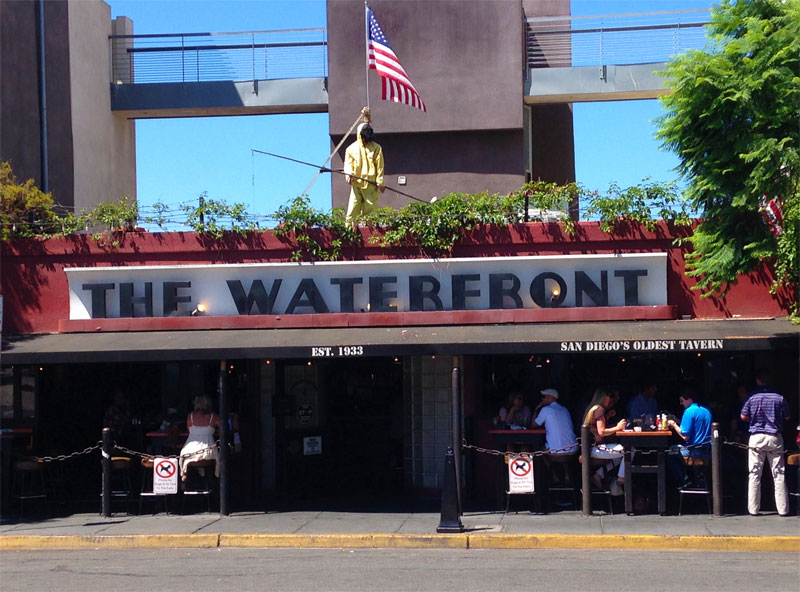
Take for example The Waterfront Bar and Grill in San Diego. This place has the oldest liquor license in the city, even though it’s not the oldest bar, it’s still pretty old, reportedly opened on December 5th, 1933. It exists in what’s now known as Little Italy, and was originally frequented by Sicilian fishermen who would mend their nets outside of the bar at the end of every day. It was truly a locals’ joint that’s over 80 years old.
Now, every year, the Waterfront celebrates Repeal Day – does anyone know what that is? That’s the day that prohibition was officially repealed – December 5, 1933. This is their biggest event of the year, and is essentially their birthday party. Their celebration includes all the normal things - live music, food and lots and lots of drinks. What’s more the cover charge for the event then goes to a local charity, turning it into a community event, which we’ll talk more about later.

Another great example is at Fraunces Tavern in New York City. Now Fraunces’ is dripping in history. It was founded as a tavern in 1762 and used as a meeting place by the Sons of Liberty. John Adams, Thomas Jefferson, and George Washington all tipped a glass here, so you’ll be drinking in good company if you stop by. Every November 25th they throw an Evacuation Day party. If you’re not familiar with that day, it marks the anniversary of the day the British left New York City in 1783. As they were boarding their ships and departing the brand new United States for good, George Washington entered the city with his army and marched right to Fraunces Tavern. There he held a night-long party, and reportedly made 13 toasts with hot-buttered rum.
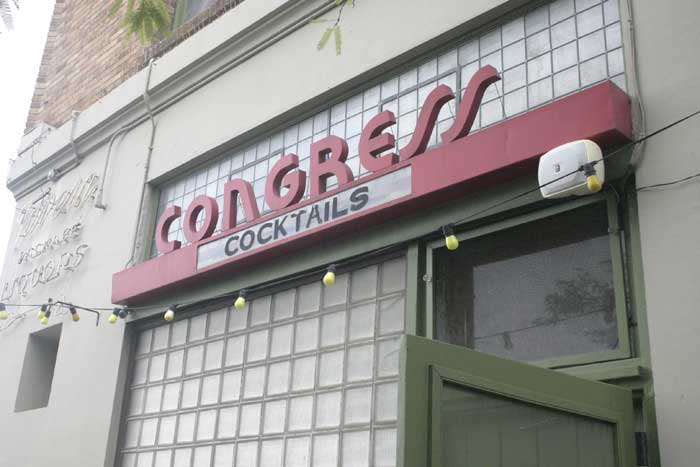
Finally let’s look at the Tap Room at the Hotel Congress in Tucson, Arizona. This hotel was opened in 1918 and was one of the few luxury hotels in the city until the 1930s. The history here is pretty astounding. Right across the street is the train station where Wyatt Earp gunned down Frank Stillwell – remember that famous scene in the movie Tombstone – “you tell ‘em I’m coming and hell’s coming with me!”. Also the place has a haunted hotel room – no joke! Anyway, in January of 1934 the hotel took on some very special guests. They turned out to be the gang of notorious bank robber, John Dillinger. Once arrested, they told police what train Dillinger would be coming into town on, and so the Tucson police were able to arrest him without firing a shot. Now, every January, the bar at the hotel celebrate Dillinger Days, with period costumes, special cocktails, and live music.
The takeaway is that if at all possible, find at least one yearly event that nobody else does, or one that nobody else can do. In each example the events had something to do with the bar itself, plus the community the bars were in. Even if you can’t do that, you can find something – maybe some obscure national day – that you can celebrate and create a unique event around that will make people talk about you.
Here are some ideas. Look at significant historical events in your city or town – when was it founded? You could use that date to throw a party and call it a Founder’s Day Party. Who founded it? You could use the birthday of the founders as a date to hold something. Or maybe celebrate some really obscure national celebration day. There’s a website called checkiday.com that will show you every national day of the year – and there are a lot of them. For example, did you know today was International Waffle Day? I can’t think of a better reason to throw a party than that!
2. Be Active in the community
The second element we noticed about most all of the places we visited was how much they were into their communities. You might know that at one time the local bar was the center of a neighborhood or maybe even a town. People got their mail there, learned about current events there, and generally treated it like we now might treat Starbucks. Well this ability to become part of the community is something the oldest bars in the nation all share in a number of ways. And as a result, they aren’t seen as just a bar, instead they’re often seen as an important and beloved institution.
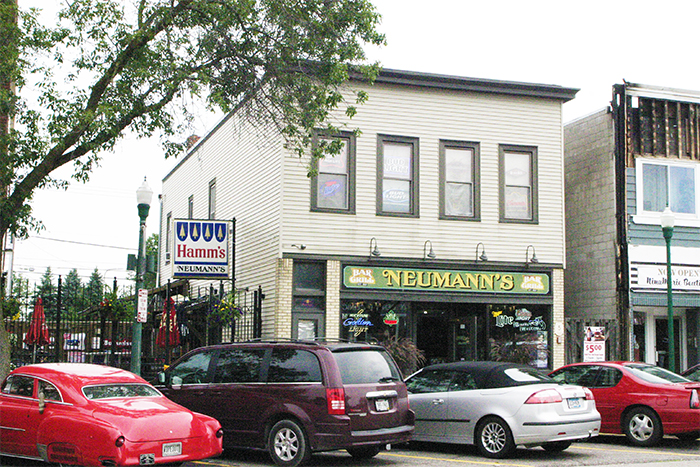
Take Neumann’s Bar in St. Paul, Minnesota. This place has been in the same spot since 1887 and is really thought of as a fixture of the city. It was originally founded as a Hamm’s Beer tied bar. Tied bars were those bars that could only serve a single type of beer – they were tied to the brewery, which usually paid for them. The bar has survived until today and is the oldest bar in Minnesota. On Fridays during the warm summer months, the neighborhood puts on a classic car show right in front of the bar.
As you can imagine, the event is huge. But instead of keeping their doors shut and making it business as usual, they hire a local band to play live music to entertain the crowds that come for the show. They also practically give away food on the sidewalk, and ultimately become part of the car show itself. By taking part in this event, by providing the entertainment for the car show, despite not making money on the band, they instead ingratiate themselves to visitors through this service.
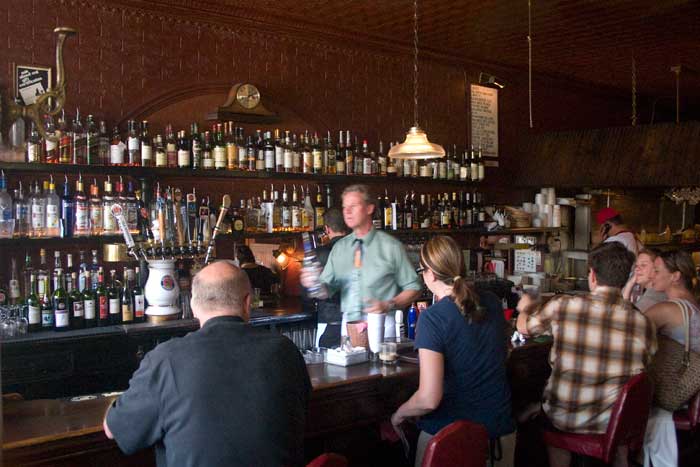
Another great story was told to us at My Brother’s Bar in Denver Colorado. A bar since 1873 this place is a local landmark, known for their burgers and great beer selection. In fact, even though it’s not that popular anymore, Columbus Day reportedly started in this bar. The bar was opened by Italian immigrants who felt that if there was a day honoring an Italian, it would raise the status of fellow immigrants, and so they started the campaign, eventually getting the day recognized in Denver, then Colorado, then the US. But today, they’re also known as community-centered people.
In the 1980s when the owner’s daughter was in Girl Scouts, the owner would buy all of her Girl Scout cookies and then resell them in the bar at cost. Well, word got around and more and more Denver Girl Scouts would show up every year to sell their cookies, and of course, Jim the owner, would buy them out too. By the time we visited the bar in 2011 there would be lines out the door every day for weeks of girls waiting to sell their cookies to My Brother’s Bar, and every year they’d drop a few thousand on Thin Mints and Somoas.
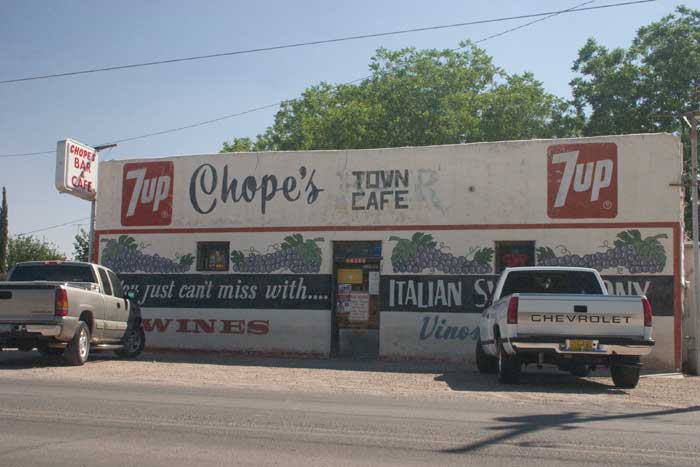
Our last example demonstrates how simple this concept can really be. Chope’s Bar, located in the village of La Mesa, New Mexico, has been renowned throughout the area for its food and margaritas since before prohibition. If you walk into this bar at any time, you’ll find yourself sitting next to a biker on one side, and a business executive on the other, It’s that much a part of the culture in the area – beloved by all. But how did it become that way? Well, frankly, because of its generosity.
If you wander into the saloon, after your eyes adjust to the dim lights, you’ll see a shelf hung close to the ceiling that runs the entire length of every wall. And on that shelf? Dozens upon dozens of trophies won by the little league, tee-ball, softball, soccer and volleyball teams they’ve sponsored over the years. Along with that you’ll see dozens of framed photos of kids in jerseys emblazoned with “Chope’s on them. After over 80 years, because of something as corny as little league sponsorships, this place has endeared itself to everyone within a sixty mile radius.
The takeaway here is that each of the places we visited somehow became more than just a bar in their communities. Bars are easy to close down, easy to complain about, easy to forget – Nobody misses them or cries when they’re gone. But something that is part of a community will be loved and cherished, and people will choose to patronize it simply out of a sense of duty.
Maybe something even more important that we’ve seen, if there’s a chance one of these places is going to close, the community immediately rallies around them, writing letters of support to the paper, encouraging others to patronize them, and generally doing whatever they can to help them. So try your best to be active in the community – not about controversial topics – but in ways that help the community realize how important you are to them. Become the lead on local fundraisers, welcome the local Rotary or Lions Clubs, sponsor little league teams, and definitely, buy Girl Scout Cookies!
3. Be Authentic
Next we want to highlight that each of the places we found for our book are absolutely authentic. None of them set out to be who they are, they just became who they are after years and years of existing. More than that, perhaps most importantly, is that they don’t try to be what they’re not. Instead they are authentic, warts and all. You see, people can spot a phony a mile away. We know that Applebee’s isn’t really part of the neighborhood, despite having local bric-a-brac on the walls. And we’re not trying to pick on Applebee’s, we’re just trying to make a point. People appreciate those things that don’t try to hide who they are.

Take Rosa’s Cantina in El Paso, Texas for example. Yes, there really is a Rosa’s Cantina in El Paso, founded in 1933, and yes, it was the place Marty Robbins sang about. This place is arguably one of the most famous bars in the world because of that famous song from 1960. Yet, looking at it, both inside and out, you’d never know. The place doesn’t have a big neon sign announcing who it is, it doesn’t have a slogan like, “as featured in the song by Marty Robbins!” Heck the place doesn’t even have a website. When you walk inside you’ll see cafeteria tables and chairs scattered around, and an old, battle scarred bar in the center.
In other words, it’s just an old neighborhood bar – no flash, no glitter. There’s a great story of the previous owner – Beto Zubia – who was running the place one day when a bus full of tourists pulled up. Beto calmly walked up to the door and locked it. The tourists piled out and found the couldn’t get in. So they stood around for maybe ten minutes knocking on the door and looking through the windows before finally getting back on the bus and leaving. When one customer asked Beto why he locked the door he replied – they would have drank all the beer! So there’s nothing that would tell you how famous it really is. And visitors appreciate that fact. They like that when they walk in, they aren’t greeted by glitz and glamor, but instead just a cozy saloon.

Another great place is Heinold’s First and Last Chance Saloon in Oakland, California. This bar was built in 1883 out of the timber from an old whaling ship. My favorite story about this place is that Jack London – the famous author who wrote The Call of the Wild among others – was practically raised in this bar. At 8 he was living on the street and the bar owner – Johnny Heinold told him to come in out of the rain one night and he never really left. Heinold bought him a dictionary to learn how to read and even sent him to UC Berkley for a couple of semester.
Anyway, Inside you find the walls littered with mementos from its past, and décor that’s been added to by local service people and Bay Area patrons over the years. The bar sits at an angle, as does the entire floor, a result of the 1906 earthquake that leveled San Francisco, and left Heinold’s in a permanent tilt. Simply put, they’ve changed nothing about this place since it was first opened, and that’s what people like about it. Had they instead at one point tried to fix the bar, level the floor, or take down some of the clutter, it just wouldn’t be the same place, and it might not even be around anymore.

A last example is the Frolic Room in Hollywood – on Hollywood Boulevard in fact. This place was a speakeasy before prohibition ended, and then went legit in 1933. It was popular with the theatre crowd from the next door Pantages Theatre, and is reportedly the last place the Black Dahlia – the famous unsolved Hollywood murder victim – was seen alive at. Over the years the bar has been in style, then out of style, then cool and retro chic.
Today it’s known as the last dive in Hollywood, as all the rest have been replaced by newer, shinier bar and grills. But the Frolic Room, with its vintage neon signage and funky decor, retains a passionate group of patrons and visitors who frequent it because it’s the same place today as it was in 1960, or even 1940. It hasn’t updated a single thing in the place, instead it’s left itself alone and not tried to chase whatever style was in style at the time. And the crowd appreciates that.
So here the takeaway is this: don’t try to be something you’re not. Don’t chase trends, because, after all, those trends will change in the blink of an eye. Instead, settle on what you want to be at the start, and then be true to that. So, if your aim is to be an authentic Irish Pub, you can’t be a karaoke lounge as well. And if you want to be a sports bar, that means you can’t also be a cocktail lounge with an innovative mixology program. It’s hard sometimes to resist the urge to change, especially when you see newer establishments going up all around you. But if people already like your bar, there’s a reason for that. Try to find out what that reason is and then focus on that instead of trying a new idea.
4. Create raving fans
Another element we noticed was how these places were able to create raving fans – people who frequent these bars all the time. We’re not talking regulars or bar-flies, but customers who feel as if they’re part of the family. A place with customers who, if they move away, they always find an excuse to come back, they also follow the bar on social media, they bring their kids when they turn 21, and they take selfies on the Great Wall of China in the bar’s t-shirt. We’ve seen all of these and more – these raving fans create a base of evangelists for these places – people who brag about them every chance they get.

The Pioneer Saloon, just outside of Las Vegas in fact, is a place that creates these types of customers. It was erected in 1913 and survived pretty much every hardship you can think of, from prohibition to great depression. It even survived despite the small town it’s in – Goodsprings – becoming a ghost town. This place is a true wild west saloon – right down to the bullet holes in the wall. People flock from all over the world to have a beer at this place, and to become a “Complete Asshole.” For a small fee, you too can be a Complete Asshole. The story goes that years ago the town mayor was discussing a toy drive for a local charity.
He was sure he’d be able to get contributions from most businesses and people in town, but not the customers down at the Pioneer Saloon, they were complete assholes. Well that got back to the owners and customers, and they got mad enough to create the Pioneer Saloon a-hole association, complete with a swearing in ceremony and certificate. And the association is still going strong – in fact Derek and I are both Complete A-holes ourselves. The money you pay still goes to the charity, they still have the member’s certificate and swearing in ceremony. Google Complete Asshole Pioneer Saloon sometime to see just how popular this is.

Another place that’s cultivated raving fans is the Buffet Bar in Tucson, Arizona. This place is practically a city landmark and has been serving the locals since 1933. On any given day they’re packed with local college students, professionals and retirees. They’re known for their happy minute – where from 5-5:01 you can have another of whatever you’re already drinking on the house. They also encourage you to draw on the walls, have pink pickled eggs in a jar, and cook hot dogs and sausages in a crock pot filled with beer.
So basically a fantastic old dive bar! But one of the most dynamic times comes when they open at 6am the morning of commencement for the University of Arizona. It’s become a tradition for graduates, alumni, parents and sometimes faculty to down as many drinks as they can fit in before graduation a few hours later. The great thing about the place is the number of second and third generation customers. Grandparents who went through the same ritual before their graduation can be seen drinking with their grandkids.
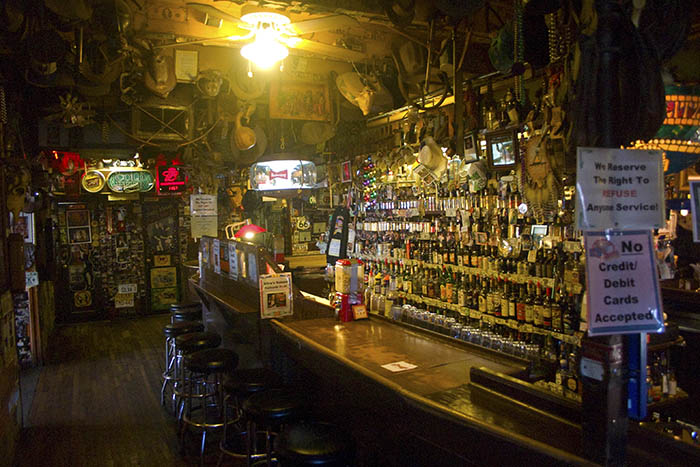
A last example would have to be a tiny dive bar called Silva’s Saloon in Bernalillo, New Mexico. When you walk in the place is covered floor to ceiling with pictures, paintings, bric-a-brac and clutter, mostly brought in by customers. At the bar in the middle is usually found Felix Silva, in his 80s and running the bar with his daughter. Felix’s dad founded this place after prohibition in 1933. We were able to visit twice, once on a Friday night and the other on Saturday morning. On Friday the place was quiet and quaint, that is until it hit 4 o’clock, and then little by little the saloon began filling up until it was shoulder to shoulder.
Now, Silva’s doesn’t serve food, just drinks. But we were told by the owner that customer often bring in food for the bar. We weren’t sure about this until we saw it for ourselves. One customer had bought a bag of chips and a jar of salsa from a local restaurant and simply put them on the bar. Another brought in a huge pot of Mexican soup called Posole. The next morning the same, as we were talking to the owner a customer walked in with a bag of burritos that he casually placed on the bar before taking a seat. The customers here didn’t just go to a bar, they went to a place they felt comfortable in, a place they cared about. And they cared enough to do something for the other people who went there as well.
The takeaway here is that these places don’t just have customers, they have super fans that think of the owners, the servers, even the other customers as if they’re family. They feel they’re part of the bar, not just patrons of it. How does that happen? We think it happens because these places follow the preceding 3 elements. Between the events, the community involvement and the authenticity, these fans become invested in these bars, and would do anything for them. So what do you do – what can you do – to transform your regulars into raving, super-mad fans of your place? The first step is to start thinking of them and treating them like more than just customers, but as people with a stake in the place. Make them feel like they are a part of it. As soon as they feel ownership, they’ll become not just regulars, but evangelists.
5. Own Your Building
The last element we want to talk about seems like a fairly simple concept, but it’s the absolute most important one for any of the bars we’ve visited to have lasted as long as they have. The element is ownership. In every case the bar’s owners actually owned the property. Without ownership we’ve seen even landmark places go under.
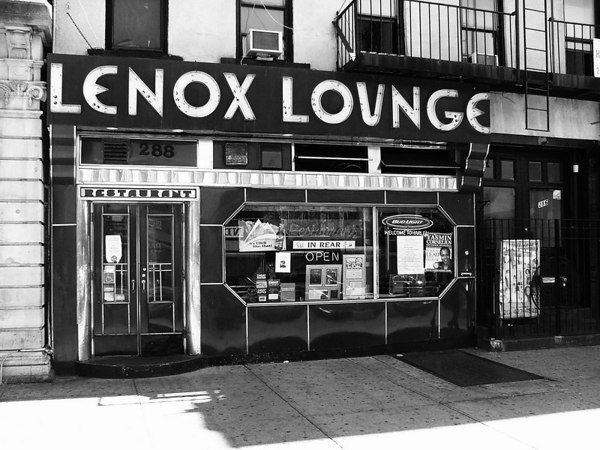
Take the Lenox Lounge, for example. It stood on Lenox Avenue in Harlam for 70 years as a jazz bar catering to a mostly African American crowd. Malcom X was known to frequent the place, as were other celebrated members of the black community. The problem was that the building wasn’t owned by the bar, it was leased. In 2012 the owner of the building tripled the rent and the bar had to close. And so not only did a great bar shutter, but a piece of history was lost that we’ll simply never get back again.
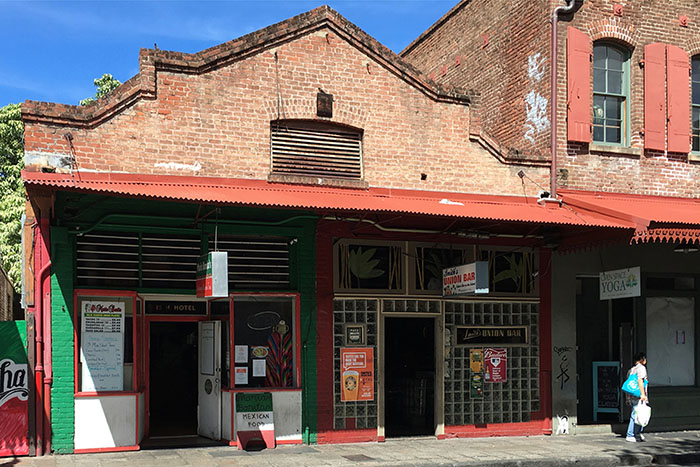
Here’s another example. One of the bar’s that’s in our book and still around is Smith’s Union Bar in Honolulu. This is the oldest bar in Hawaii, opened in 1933. This tiny dive is dark and cramped but has a ton of history. It turned out that not only was this the last bar left from Chinatown’s seedy past, but it was also the bar that the crew of the USS Arizona would frequent and hang out at. So needless to say, the place has got stories for miles. The problem is that they don’t own the building and are under constant threat of losing the place – especially as Honolulu’s downtown sees a revitalization. They’re trying to get a historical designation for the bar as a way to create legitimacy and stay around. But only time will tell if that actually works or not.
We can also look at New York’s classic pubs, like McSorley’s, Pete’s, the Ear Inn, and Old Town Bar. Each of these were opened in the 19th century by early immigrants to New York City, each is now a city landmark prominently featured in travel guides – aside from ours - and in each case the owners of the bars own the buildings that house them. If not for that, there’s a pretty good chance none of them would be around any longer considering the price of real estate in Manhattan.
In fact we’d venture to guess that over 90% of the places in our book are owned by the bar owners, and that’s probably why they’re still around.
The takeaway is pretty easy to see here. If you plan on having a successful, long-lasting bar, then owning the building that houses it is almost essential. Without that you’re at the mercy of the landlord, and we’ve seen dozens of stories of places just like the Lenox Lounge. Places that are by all means historic, but that, at the end of the day, were nothing more than a tenant – ultimately disposable at the end of the day.
So there you go – 5 things the oldest bars in the country have in common. There’s more to their longevity than just these 5 things, sometimes there’s simply a lot of luck, but in the end these are traits that all of them had, and we think that alone is reason to consider them yourself in your own places.
Thanks for reading, we hope you got something out of it. If you need to ever contact us, we can be reached here on our website.
Cheers!

